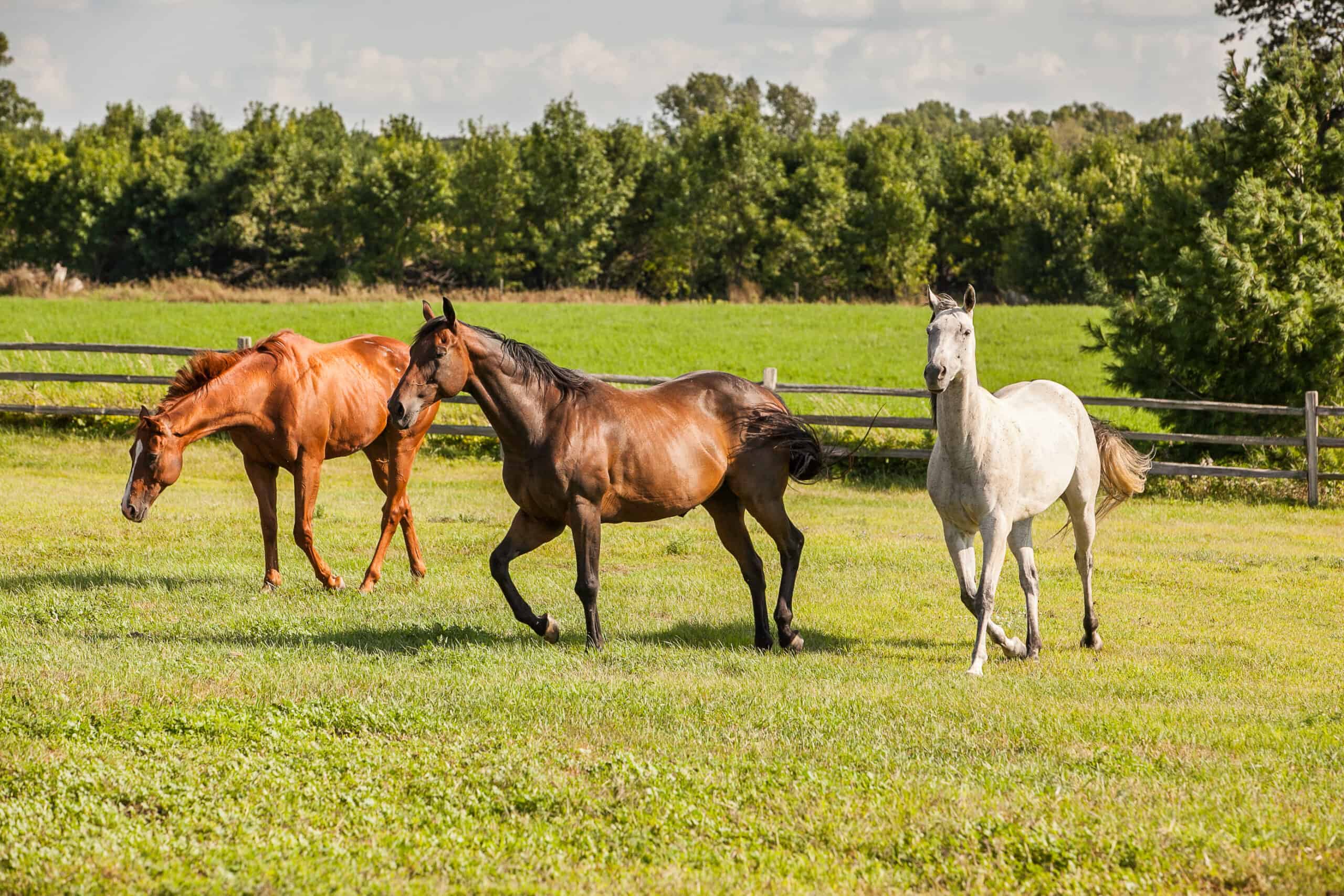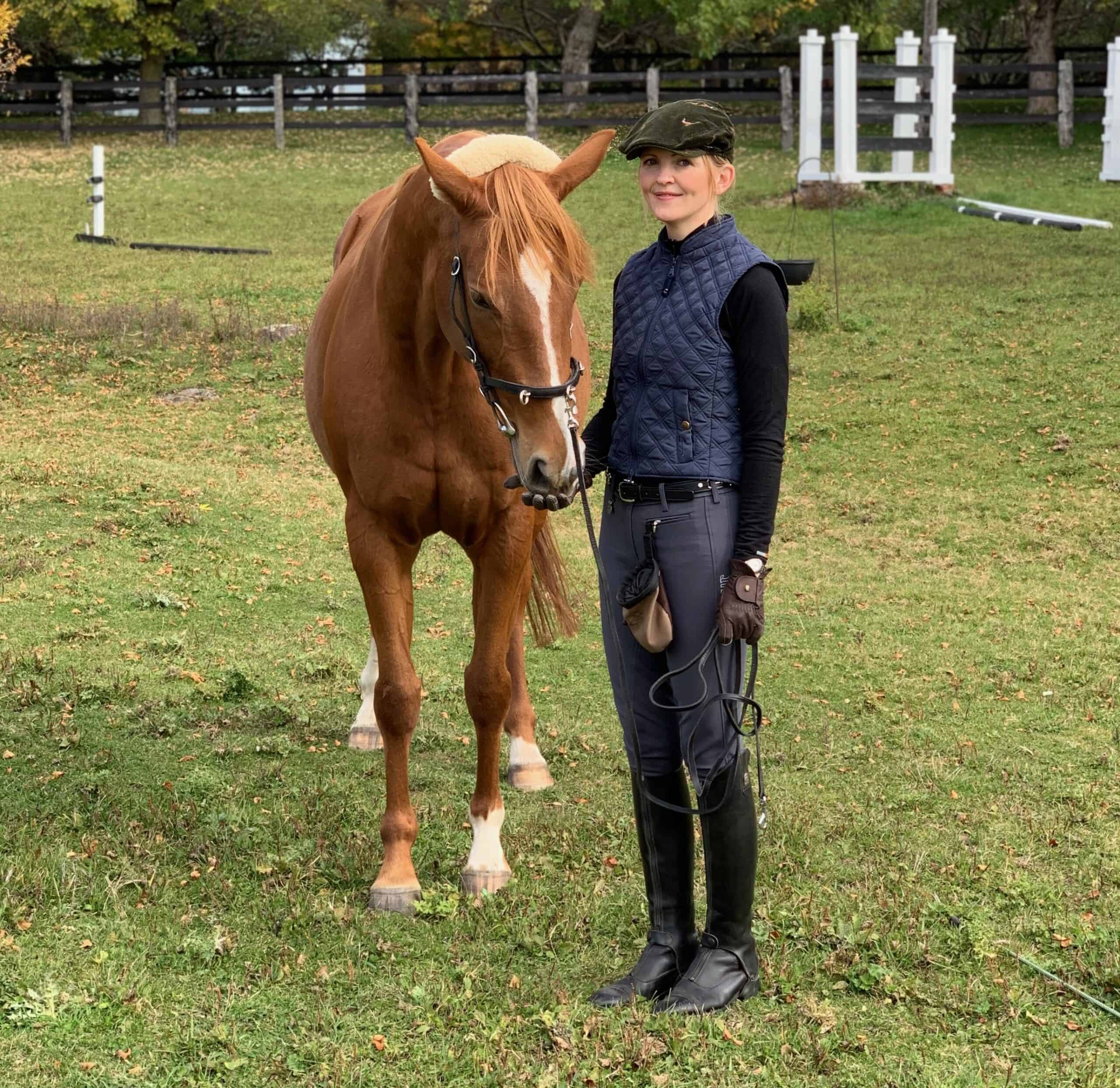Introducing an Aggressive Horse in a New Herd
- Topics: Article, Basic Care, Behavior & Handling, Equine Behavior, Horse Care, Safety

Horses are highly social and have evolved to live in groups for survival. Naturally, horses display more cooperative behavior toward other equids, but aggression is also part of a horse’s behavior repertoire when interacting with horses, humans, and other species. “Aggression is very rare in horses and encourages others to, for instance, increase the distance, go away/give way, stop trying to play or get my food,” says Debbie Marsden, BSc, PhD, SEBC registered senior horse behavior consultant. She adds that those aggressive encounters rarely result in serious injury to other horses but can be fatal if redirected toward people.
Is My Horse’s Behavior Aggression or Play?
“What might be called aggression could be normal social behavior, particularly social agonistic behavior, good maternal behavior, a sign of injury or illness, self-defense if frightened, being hurt and trapped, instinctive reaction to predators/predator like animals, or the last resort when social behavior fails,” Marsden explains. “Play behavior with head-arching, tossing, rearing, spinning, stomping onto the ground, etc., is often mistaken for aggression, especially if redirected towards people. Defensive (‘real’) aggression is only seen where a horse is frightened or being hurt and trapped.”
“Where aggression is seen in other situations and directed towards all other horses, animals, or humans, it is highly likely that there is a pathological physical cause, and this needs to be addressed urgently by thorough veterinary investigation,” she added.
Why Do Domesticated Horses Behave Aggressively?
Horses evolved to use movement, aka flight, to escape threats, says Debbie Busby, MSc, PhD researcher at the Manchester Metropolitan University, in the U.K., and registered/certified clinical animal behaviorist. “Domesticated horses may often find themselves in situations where flight is not an option—being physically restrained (e.g., halters, riding equipment) or spatially restricted (e.g., fencing, stalls). Consequently, agonistic or ‘fight’ behavior may ensue due to the horses’ objective of creating a distance between themselves and the trigger. Since the horse cannot simply walk away, the next option is to appear scary and threaten to create that distance. If threats are unsuccessful, the horse may escalate to actual biting and kicking,”
Possible causes of aggression and contributing factors can include illness, pain, memory of pain, fear of a real or perceived threat, competition between horses due to insufficient resources (e.g., water, shelter, forage/grazing space, breeding partner), anxiety, acute/chronic or post-traumatic stress, learned emotional response, turnout in an unfamiliar horse group, or constant changes within a group of horses, Marsden notes.
“Because of the factors involved in how a ‘captive managed’ horse’s life is organized, in contrast to a free-roaming horse, maladaptive aggressive behavior is more likely—nearly all relate to some degree or other to the effect of human intervention in the horse’s life,” Busby adds. “Aggressive behavior in free-roaming groups is usually related to resource-holding contests or competition for a mate.”
The Problems With ‘Man-Made Herds’
Busby explains that horses evolved to live in consistent, ethologically stable natal bands. “A herd, in ethological terms, is a socially complex group of bands that may overlap spatially for reasons of resource availability or safety,” she says. “A group of horses managed by humans in the changeable ways described above cannot be described as a ‘herd’ in that sense.”
When people add a new horse to a group of horses, the involved horses have no choice whether to join and/or accept the new horse(s). The new horse might have recently moved to this new stable and has yet to become familiar with the location of feed and water sources in the turnout field. Busby says existing group members may also sense potential threat and experience uncertainty because they are unfamiliar with the new horse.
“The aggression that we may perceive in the new horse is likely to be defensive aggression in an attempt to protect themselves from actual or expected agonistic behavior from some of the existing group members,” she says.
How Do I Introduce a Horse to a New Herd?
Never introduce a known horse-aggressive horse into a herd, Busby says, because this can risk injury and negatively impact long-term relationships within the herd, and the risks might outweigh the benefits (such as meeting horses’ social needs, such as play and mutual grooming). “If the new horse is known to be aggressive, have them in a separate field where they can see, smell, and hear the other horses to take in information,” Busby says.
Both she and Marsden stress the importance of seeking a qualified veterinarian to rule out pain—acute and/or chronic pain can trigger aggressive behavior—and/or conditions such as hormonal imbalances in these horses.
Owners can minimize the risks of their horses sustaining kick or bite injuries from normal social behavior when (non-horse-aggressive) new horses are correctly introduced to a new group.
Marsden suggests considering the following steps, which apply to horses not showing true aggression:
- Introduce the new horse gradually to the other horses; for instance, keep the horse in a safe, secure stall, paddock, or field next to the other horses first.
- Ride together with horses from the new herd a few times, being sure to maintain a safe distance so they cannot kick or bite one another.
- Remove shoes, blankets/sheets, and halters, or only use safety halters to enhance safety and reduce injury risk.
- Introduce the new horse during the daytime when other horse-experienced people are around to help catch horses or call a veterinarian in an emergency.
- Select the largest field available and introduce the new horse to a large and well-established horse group.
- Offer plentiful resources scattered around the field and, ideally, introduce the new horse during the warmer months when grazing is possible.
- Ensure the corners are temporarily fenced off to prevent horses from being cornered by field mates.
- Turn out the new horse last and take it out of the herd first.
- If the new horse is a mare, don’t introduce her when in season or coming into season.
Remember to protect yourself, as well; always wear protective equipment when around the horses.
Sometimes Turning Out Aggressive Horses Alone Is Best
Although group living is generally ideal, it may not work well for all horses and can compromise their welfare, says Marsden.
“Think about the risks and the potential for injury to horses and people,” she says. “Keeping a known aggressive horse alone in his paddock may be much better and safer in the long run. Sadly, this will not help improve social skills due to the restricted social experience but is usually the safest option.”
A small percentage of horses, particularly those with poor social skills, settle well when turned out alone.
Take-Home Message
“Resolve the aggressive behavior first,” says Busby. “Seek veterinarian and behavioral advice to make the best choices for the aggressive horse’s safety as well as the owner, barn staff and other horses.”
Sometimes the safety of all horses and handlers involved, the risk of serious injury, and the negative impact an aggressive horse might have on the mental state of all involved horses outweigh the benefits of herd turnout.

Written by:
Tanja Bornmann
Related Articles
Stay on top of the most recent Horse Health news with















